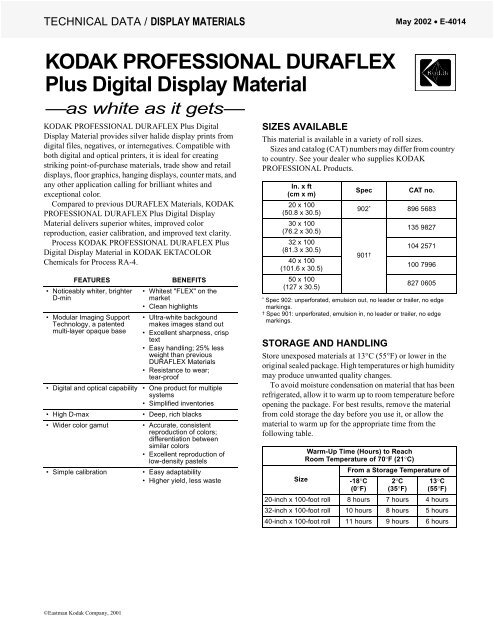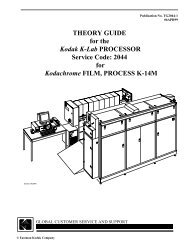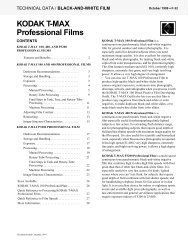KODAK PROFESSIONAL DURAFLEX Plus Digital Display ... - 125px
KODAK PROFESSIONAL DURAFLEX Plus Digital Display ... - 125px
KODAK PROFESSIONAL DURAFLEX Plus Digital Display ... - 125px
You also want an ePaper? Increase the reach of your titles
YUMPU automatically turns print PDFs into web optimized ePapers that Google loves.
TECHNICAL DATA / DISPLAY MATERIALS<br />
<strong>KODAK</strong> <strong>PROFESSIONAL</strong> <strong>DURAFLEX</strong><br />
<strong>Plus</strong> <strong>Digital</strong> <strong>Display</strong> Material<br />
—as white as it gets—<br />
<strong>KODAK</strong> <strong>PROFESSIONAL</strong> <strong>DURAFLEX</strong> <strong>Plus</strong> <strong>Digital</strong><br />
<strong>Display</strong> Material provides silver halide display prints from<br />
digital files, negatives, or internegatives. Compatible with<br />
both digital and optical printers, it is ideal for creating<br />
striking point-of-purchase materials, trade show and retail<br />
displays, floor graphics, hanging displays, counter mats, and<br />
any other application calling for brilliant whites and<br />
exceptional color.<br />
Compared to previous <strong>DURAFLEX</strong> Materials, <strong>KODAK</strong><br />
<strong>PROFESSIONAL</strong> <strong>DURAFLEX</strong> <strong>Plus</strong> <strong>Digital</strong> <strong>Display</strong><br />
Material delivers superior whites, improved color<br />
reproduction, easier calibration, and improved text clarity.<br />
Process <strong>KODAK</strong> <strong>PROFESSIONAL</strong> <strong>DURAFLEX</strong> <strong>Plus</strong><br />
<strong>Digital</strong> <strong>Display</strong> Material in <strong>KODAK</strong> EKTACOLOR<br />
Chemicals for Process RA-4.<br />
FEATURES BENEFITS<br />
• Noticeably whiter, brighter<br />
D-min<br />
Modular Imaging Support<br />
Technology, a patented<br />
multi-layer opaque base<br />
©Eastman Kodak Company, 2001<br />
Whitest "FLEX" on the<br />
market<br />
Clean highlights<br />
Ultra-white backgound<br />
makes images stand out<br />
Excellent sharpness, crisp<br />
text<br />
Easy handling; 25% less<br />
weight than previous<br />
<strong>DURAFLEX</strong> Materials<br />
Resistance to wear;<br />
tear-proof<br />
<strong>Digital</strong> and optical capability One product for multiple<br />
systems<br />
Simplified inventories<br />
High D-max Deep, rich blacks<br />
Wider color gamut Accurate, consistent<br />
reproduction of colors;<br />
differentiation between<br />
similar colors<br />
Excellent reproduction of<br />
low-density pastels<br />
Simple calibration Easy adaptability<br />
Higher yield, less waste<br />
May 2002 • E-4014<br />
SIZES AVAILABLE<br />
This material is available in a variety of roll sizes.<br />
Sizes and catalog (CAT) numbers may differ from country<br />
to country. See your dealer who supplies <strong>KODAK</strong><br />
<strong>PROFESSIONAL</strong> Products.<br />
In. x ft<br />
(cm x m)<br />
20 x 100<br />
(50.8 x 30.5)<br />
30 x 100<br />
(76.2 x 30.5)<br />
32 x 100<br />
(81.3 x 30.5)<br />
40 x 100<br />
(101.6 x 30.5)<br />
50 x 100<br />
(127 x 30.5)<br />
Spec CAT no.<br />
902 * 896 5683<br />
901 †<br />
135 9827<br />
104 2571<br />
100 7996<br />
827 0605<br />
* Spec 902: unperforated, emulsion out, no leader or trailer, no edge<br />
markings.<br />
† Spec 901: unperforated, emulsion in, no leader or trailer, no edge<br />
markings.<br />
STORAGE AND HANDLING<br />
Store unexposed materials at 13°C (55°F) or lower in the<br />
original sealed package. High temperatures or high humidity<br />
may produce unwanted quality changes.<br />
To avoid moisture condensation on material that has been<br />
refrigerated, allow it to warm up to room temperature before<br />
opening the package. For best results, remove the material<br />
from cold storage the day before you use it, or allow the<br />
material to warm up for the appropriate time from the<br />
following table.<br />
Size<br />
Warm-Up Time (Hours) to Reach<br />
Room Temperature of 70°F (21°C)<br />
From a Storage Temperature of<br />
-18°C<br />
(0°F)<br />
2°C<br />
(35°F)<br />
13°C<br />
(55°F)<br />
20-inch x 100-foot roll 8 hours 7 hours 4 hours<br />
32-inch x 100-foot roll 10 hours 8 hours 5 hours<br />
40-inch x 100-foot roll 11 hours 9 hours 6 hours
DARKROOM RECOMMENDATIONS<br />
Handle these materials in total darkness. Be sure that your<br />
printing and processing darkrooms are lighttight. Carefully<br />
control stray light within your printing equipment.<br />
Note: Using a safelight will affect your results. These<br />
materials are much faster than traditional materials. They are<br />
very sensitive to safelights; sensitometric shifts can occur<br />
before you observe any changes in D-min.<br />
EXPOSURE<br />
<strong>Digital</strong> Printing<br />
Expose these materials in various types of digital enlargers<br />
and printers, such as (but not limited to)—<br />
DURST Lambda 130 and DURST Epsilon <strong>Digital</strong> Laser<br />
Imagers<br />
Gretag Imaging LIGHTJET Series or <strong>Digital</strong> Recorder<br />
Because there are numerous manufacturers and models of<br />
digital writers, we cannot provide starting-point exposure<br />
calibration aims for all equipment. We recommend that you<br />
test the materials and calibrate your printer to achieve<br />
optimum results.<br />
For optimum results, follow your equipment<br />
manufacturer’s recommendations for calibrating your<br />
printing equipment.<br />
Calibrating the DURST Laser Imagers<br />
For DURST Lambda <strong>Digital</strong> Laser Imagers, basic<br />
calibration starting values follow. The values are based on<br />
readings from an X-RITE DTP-36 Densitometer.<br />
Process<br />
RA-4<br />
RA-4<br />
Process<br />
RA-4<br />
RA-4<br />
DURST Lambda 130 and 76 Laser Imager<br />
D-max<br />
R = 235<br />
G = 230<br />
B = 225<br />
DURST Epsilon Laser Imager<br />
D-max<br />
R = 2.30<br />
G = 2.20<br />
B = 2.10<br />
Basic Calibration<br />
(Starting Values)<br />
Y = 69.77<br />
M = 54.48<br />
C = 0.0<br />
D = 119.27<br />
Basic Calibration<br />
(Starting Values)<br />
Y = 0.216<br />
M = 0.239<br />
C = 0.000<br />
D = 0.845<br />
IMPORTANT:<br />
1. Using higher D-max values than those listed above may<br />
result in:<br />
overexposure<br />
small text closing up; unsharp text<br />
oversaturated colors in step 21 (e.g., red becomes<br />
orange, etc.)<br />
insufficient laser power for exposure to start<br />
2. When using the above starting values for the basic<br />
calibration, load the paper as “New Paper Type,” and<br />
do not copy an already calibrated channel.<br />
3. Your Process RA-4 must be to aim and reach a density<br />
of 2.10 in each color on D-max of your process control<br />
strip; otherwise you may have problems reaching<br />
D-max. Also, you may experience a yellow halo around<br />
black text and you will not get a pure white.<br />
4. To obtain a neutral gray, use a lower D-max for blue<br />
than for red and green.<br />
(Example: R = 230, G = 215, B = 200)<br />
Calibrating the Gretag Imaging LIGHTJET Printer<br />
Calibration targets for the Gretag Imaging LIGHTJET<br />
Printers must be downloaded from www.cymbolic.com.<br />
Select Service/Support<br />
Select FTP site<br />
Select LightJet 5000 and 430 material files<br />
Select LightJet 430 & 5000<br />
Select LightJet-Fusion<br />
Select appropriate printer LightJet 430 or LightJet 5000<br />
Select appropriate computer DecAlpha or Intel<br />
Click on Kodak Duraflex <strong>Plus</strong> - revA.exe<br />
This will download an executable to your hard drive. Once<br />
run, it will place the targets in the appropriate folder.<br />
Create a new configuration in Fusion and calibrate.<br />
Optical Printing<br />
Expose these materials with enlargers equipped with<br />
tungsten or tungsten-halogen light sources or photo enlarger<br />
lamps (e.g., No. 212 or 302).<br />
For best results with these materials, use a black-base<br />
printing easel with easel blades to prevent reflections. Using<br />
a light-colored easel can affect color balance. Tape (or any<br />
other material that can cause a reflection on the printing<br />
easel) may form an image through the base of the material.<br />
You can also expose <strong>DURAFLEX</strong> <strong>Plus</strong> <strong>Digital</strong> <strong>Display</strong><br />
Material in automatic printers, such as the <strong>KODAK</strong> 3510,<br />
2610, 2620, or 312 Color Printer or <strong>KODAK</strong> MC <strong>Digital</strong> or<br />
S-Type Color Printers. Set up and balance printers according<br />
to the manufacturer’s instructions. If your printer is equipped<br />
with a punching device, turn the punch off; it may not be able<br />
to punch through the polyester base.<br />
Do not use fluorescent lamps to expose these materials.<br />
Use a heat-absorbing glass to remove infrared radiation.<br />
Because voltage changes affect light output and color<br />
quality, use a voltage regulator.<br />
Keep negatives and the equipment optical system clean.<br />
Mask negatives to eliminate stray light. You can use the<br />
white-light or the tricolor exposure method.<br />
2 <strong>KODAK</strong> <strong>PROFESSIONAL</strong> <strong>DURAFLEX</strong> <strong>Plus</strong> <strong>Digital</strong> <strong>Display</strong> Material • E-4014
White-Light Exposure Method<br />
Control color balance with dichroic filters built into the<br />
enlarger or printer, or with <strong>KODAK</strong> Color Printing (CP)<br />
Filters (Acetate) or <strong>KODAK</strong> Color Compensating (CC)<br />
Filters (Gelatin) placed between the lamp and the negative.<br />
You can also use CC filters between the negative and the<br />
material; however, use as few filters as possible—preferably<br />
not more than three. You can use any number of filters<br />
between the light source and the negative. If you use cyan<br />
filtration, use filters with the suffix “-2” (e.g.,”CP10C-2”).<br />
To begin, make a test print with a starting filter pack of<br />
50M + 30Y. Adjust the exposure to obtain satisfactory<br />
density; adjust the filtration, if necessary, to change color<br />
balance.<br />
Tricolor Exposure Method<br />
Use <strong>KODAK</strong> WRATTEN Gelatin Filters No. 25 (red),<br />
No. 99 (green), and No. 47B (blue) to give the material three<br />
separate, consecutive exposures, one through each of the<br />
filters. Be careful not to move the material or the enlarger<br />
until you have made all three exposures. Typical exposure<br />
times at f/8 for making a 3X enlargement from a normally<br />
exposed negative are given in the table below.<br />
Filter Times for an Aperture Setting of f/8 *<br />
Red 3.5 seconds<br />
Green 3.9 seconds<br />
Blue 6.5 seconds<br />
* For an enlarger equipped with a Photo Enlarger Lamp No. 212 or<br />
No. 302; the setting may vary with other types of lamps.<br />
LATENT-IMAGE KEEPING<br />
There may be some noticeable shifts in the images if the time<br />
between and process is inconsistent. For best results, hold<br />
your exposed images for at least 10 minutes prior to<br />
processing.<br />
PROCESSING<br />
Use <strong>KODAK</strong> EKTACOLOR Chemicals for Process RA-4 in<br />
continuous or roller-transport processors.Your processor<br />
must be capable of handling the 9-mil polyester base. Use the<br />
same machine settings that you currently use for traditional<br />
print materials.<br />
Underdrying can produce tackiness that tends to make<br />
paper stick when it is wound into rolls before cutting.<br />
Overdrying can cause curl and complicate transport in print<br />
finishing. Do not use drying temperatures above 93°C<br />
(200°F) to avoid damage to prints.<br />
For more information, see <strong>KODAK</strong> Publication<br />
No. Z-130, Using <strong>KODAK</strong> EKTACOLOR Chemicals on our<br />
website at www.kodak.com/go/photochemicals.<br />
VIEWING<br />
Evaluate prints under lights of the same color quality and<br />
brightness that you will use to view the final prints. A good<br />
average condition is a light source with a color temperature<br />
of 5000 K ± 1000, a Color Rendering Index of 85 to 100, and<br />
an illuminance of at least 50 footcandles (538 lux).<br />
Fluorescent lamps such as cool white deluxe (made by<br />
several manufacturers) meet these conditions.<br />
You can also use a mixture of incandescent and<br />
fluorescent lamps. For each pair of 40-watt cool white<br />
deluxe fluorescent lamps, use a 75-watt frosted, tungsten<br />
bulb.<br />
Viewing conditions should meet ANSI Standard<br />
PH2.30-1989.<br />
POST-PROCESS TREATMENTS<br />
Spotting and Retouching<br />
Retouch or spot this material with the same methods used for<br />
<strong>KODAK</strong> EKTACOLOR Papers. The dye stability of this<br />
material will not be affected if the instructions given in<br />
<strong>KODAK</strong> Publication E-70, Retouching Prints on <strong>KODAK</strong><br />
EKTACOLOR and EKTACHROME Papers, are followed.<br />
Laminating Prints<br />
You can laminate prints on <strong>DURAFLEX</strong> <strong>Plus</strong> <strong>Digital</strong><br />
<strong>Display</strong> Material. Laminate both sides of identification<br />
cards to protect against moisture.<br />
Notice: Many municipalities have adopted as part of their<br />
local fire codes the National Fire Protection Association<br />
(NFPA) 701-1999 Standard Methods of Fire Tests for<br />
Flame Propagation of Textiles and Films, which applies to<br />
plastic films used for decorative or other purposes inside<br />
buildings. To comply with this standard, you must protect<br />
displays using any of these plastic films.<br />
We strongly recommend that you take one or both of the<br />
following measures to protect all large displays, especially if<br />
the material is displayed in a public area:<br />
Fully enclose the materials in a light box or an<br />
illuminator.<br />
Frame and laminate the materials to a non-combustible<br />
mounting board, wall, glass, or1/4-inch or thicker<br />
polycarbonate, e.g., Lexan, support.<br />
Other standards covering the burning characteristics of<br />
these products may apply to markets outside the U.S. Check<br />
with the appropriate local agency. Do not use these materials<br />
as backdrop displays in theaters.<br />
For more information, see CIS-37, Combustion of<br />
<strong>KODAK</strong> Films, Resin-Coated Photographic Papers, and<br />
Print and <strong>Display</strong> Materials.<br />
<strong>KODAK</strong> <strong>PROFESSIONAL</strong> <strong>DURAFLEX</strong> <strong>Plus</strong> <strong>Digital</strong> <strong>Display</strong> Material • E-4014 3
CURVES<br />
DENSITY<br />
3.0<br />
2.0<br />
1.0<br />
0.0<br />
3.0<br />
F002_1167AC<br />
Characteristic Curves<br />
Process:<br />
45 seconds<br />
Densitometry: Status A<br />
o o<br />
RA-4, 95 F (35 C),<br />
B<br />
G<br />
2.0<br />
1.0<br />
0.0<br />
LOG EXPOSURE (lux-seconds)<br />
*<br />
LOG SENSITIVITY<br />
2.0<br />
1.0<br />
0.0<br />
1.0<br />
2.0<br />
R<br />
1.0<br />
Spectral-Dye-Density Curves<br />
Process: RA-4<br />
4 <strong>KODAK</strong> <strong>PROFESSIONAL</strong> <strong>DURAFLEX</strong> <strong>Plus</strong> <strong>Digital</strong> <strong>Display</strong> Material • E-4014<br />
DIFFUSE SPECTRAL DENSITY<br />
2.5<br />
2.0<br />
1.5<br />
1.0<br />
0.5<br />
0.0<br />
400<br />
F009_0421AC<br />
Spectral-Sensitivity Curves<br />
Process: RA-4<br />
Yellow-<br />
Forming<br />
Layer<br />
Magenta-<br />
Forming<br />
Layer<br />
Yellow<br />
Cyan-<br />
Forming<br />
Layer<br />
500<br />
250 300 350 400 450 500 550 600 650 700<br />
750<br />
WAVELENGTH (nm)<br />
*Sensitivity = reciprocal of exposure (erg/cm ) required<br />
to produce specified density<br />
F009_0420AC<br />
Magenta<br />
600<br />
WAVELENGTH (nm)<br />
NOTICE: The sensitometric curves and data in this publication represent product tested<br />
under the conditions of exposure and processing specified. They are representative of<br />
production coatings, and therefore do not apply directly to a particular box or roll of<br />
photographic material. They do not represent standards or specifications that must be met<br />
by Eastman Kodak Company. The company reserves the right to change and improve<br />
product characteristics at any time.<br />
2<br />
Cyan<br />
700
MORE INFORMATION<br />
Kodak has many publications to assist you with information<br />
on Kodak products, equipment, and materials.<br />
The following publications are available from dealers who<br />
sell Kodak products, or you can contact Kodak in your<br />
country for more information.<br />
E-30 Storage and Care of <strong>KODAK</strong> Photographic<br />
Materials—Before and After Processing<br />
E-70 Retouching Prints on <strong>KODAK</strong> EKTACOLOR<br />
and EKTACHROME Papers<br />
E-71 Retouching Color Negatives<br />
E-176 Post-Processing Treatment of Color Prints—<br />
Effects on Image Stability<br />
J-39 Tray, Drum, and Rotary-Tube Processing with<br />
<strong>KODAK</strong> EKTACOLOR RA Chemicals<br />
K-4 How Safe is Your Safelight?<br />
Z-130 Using <strong>KODAK</strong> EKTACOLOR RA Chemicals<br />
For the latest version of technical support publications for<br />
<strong>KODAK</strong> <strong>PROFESSIONAL</strong> Products, visit Kodak on-line at:<br />
http://www.kodak.com/go/professional<br />
If you have questions about <strong>KODAK</strong> <strong>PROFESSIONAL</strong><br />
Products, call Kodak.<br />
In the U.S.A.:<br />
1-800-242-2424, Ext. 19, Monday–Friday<br />
9 a.m.–7 p.m. (Eastern time)<br />
In Canada:<br />
1-800-465-6325, Monday–Friday<br />
8 a.m.–5 p.m. (Eastern time)<br />
Note: The Kodak materials described in this publication for<br />
use with <strong>KODAK</strong> <strong>PROFESSIONAL</strong> <strong>DURAFLEX</strong> <strong>Plus</strong><br />
<strong>Digital</strong> <strong>Display</strong> Material are available from dealers who<br />
supply <strong>KODAK</strong> <strong>PROFESSIONAL</strong> Products. You can use<br />
other materials, but you may not obtain similar results.<br />
<strong>KODAK</strong> <strong>PROFESSIONAL</strong> <strong>DURAFLEX</strong> <strong>Plus</strong> <strong>Digital</strong> <strong>Display</strong> Material • E-4014 5
<strong>KODAK</strong> <strong>PROFESSIONAL</strong> <strong>DURAFLEX</strong> <strong>Plus</strong> <strong>Digital</strong> <strong>Display</strong> Material<br />
<strong>KODAK</strong> <strong>PROFESSIONAL</strong><br />
<strong>DURAFLEX</strong> <strong>Plus</strong> <strong>Digital</strong> <strong>Display</strong><br />
Material<br />
<strong>KODAK</strong> Publication No. E-4014<br />
Kodak, Kodak Professional, Duraflex, Ektacolor, Wratten, and Ektachrome are<br />
trademarks.<br />
Minor Revision 5-02<br />
Printed in U.S.A.

















